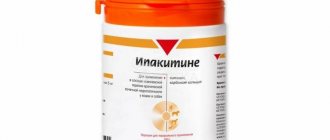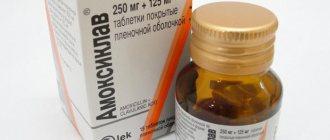Release form and composition of the drug Furosemide
Available in the form of a solution intended for injection and tablets.
- White tablets Each unit contains 40 ml of the active ingredient (furosemide).
- The solution is almost transparent with a slight yellow tint. The concentration of the active substance is 5% (in 1 ml of solution 50 mg of furosemide). The medicine is bottled in dark glass bottles with a capacity of 50 or 100 ml.
For injection solution the following are used:
- sodium metabisulfide;
- methyl parahydroxybenzoate;
- propyl parahydroxybenzoate;
- sodium hydroxide (pH correction);
- water for injections.
In addition to the main substance, the tablets contain:
- povidone;
- lactose;
- MCC;
- gelatin;
- potato starch;
- colloidal silicon dioxide;
- magnesium stearate;
- talc.
Furosemide: instructions for use in veterinary medicine
The active component of the drug is the chemical compound of the same name, which helps remove excess fluid from the body. It belongs to the group of loop diuretics, characterized by a rapid onset of therapeutic effect (within half an hour) and an average duration of action of no more than 5 hours. In addition, this group of drugs actively washes away vital microelements such as magnesium and potassium along with water.
Dosages and prices
Furosemide is produced by many pharmaceutical companies. It can also be used in veterinary medicine, following the recommended dosages. Also, veterinary pharmacies sell a specialized drug in the form of a solution for injections (injections) produced in the Netherlands. The price of “human” Furosemide is determined by the manufacturer:
- tablets 40 mg, 20 pcs. – 25 rubles;
- tablets 40 mg, 50 pcs. – 23-32 rub.;
- solution 1% 2 ml, 10 ampoules – 22-32 rubles.
Indications for use and mechanism of action
The active component disrupts the reverse absorption of chlorine and sodium ions, as a result of which fluid is removed from the body along with potassium, magnesium, and calcium ions.
The pharmacological effect occurs half an hour after taking the drug, and the effect lasts about 4 hours. The active substance is converted into glucuropide during the process of biotransformation and is excreted from the body naturally (with urine).
Furosemide is given to cats for severe hypertension
Furosemide is prescribed to cats and cats with the manifestation of edema syndrome, which is characteristic of the following diseases:
- hypertension (severe);
- cirrhosis of the liver;
- pulmonary edema;
- ascites (with liver cancer);
- heart failure (chronic form);
- renal dysfunction, prerenal uremia.
Indications for use of the drug
Furosemide is prescribed to cats when they develop swelling caused by the following reasons:
- severe form of hypertension;
- cirrhosis of the liver;
- with edema of the lungs, heart, brain;
- accumulation of fluid in the abdominal cavity due to liver disease;
- chronic heart failure;
- abnormal kidney function;
- intoxication or poisoning.
Furosemide is given to cats for severe hypertension
This is interesting: Who is better, a cat or a dog?
Diuretic dosage for cats and method of application
The veterinarian is responsible for developing the dosage regimen and calculating the daily dose. When determining the dosage, the etiology of the disease, the weight of the animal and the presence of complications are taken into account.
The daily dose of the tablet product for cats is 5-6 mg per 1 kg of body weight (solution - 0.5-06 ml per 10 kg of weight). For dogs, the norm increases to 8-10 mg per 1 kg of body weight (solution - 0.7-1 ml per 10 kg of weight). Depending on the severity of the disease and the intensity of the development of swelling, the dosage may be doubled.
The Furosemide treatment regimen involves a single dose of the drug 30-40 minutes before meals.
During research, the effect of the active substance on pregnancy has not been thoroughly studied, but it is known that the drug overcomes the placental barrier and can have a negative effect on the fetus. Therefore, experts do not recommend using the drug at this stage of life.
The drug is prescribed only when absolutely necessary in the second half of pregnancy.
Pregnant cats should only be prescribed the drug as a last resort.
It is not recommended to give this drug to an animal during lactation. The active component has the ability to suppress the milk production process. In addition, breast milk contains a small concentration of Furosemide, which can negatively affect the health of the offspring.
Furosemide for cats
: 08 Nov 2014, 17:38
Diuretics for animals are mainly used for edema and kidney disease in pets. Less commonly, diuretics are prescribed to animals in cases where it is necessary to remove poisons and toxins from the body, for example, after poisoning.
When choosing which diuretic to use to treat animals, veterinarians usually focus on Purine derivatives and such drugs as:
- Temisal;
- Eufillin;
- Mercuzal;
- Potassium acetate;
- Juniper berries;
- Bearberry leaf;
- Hexamethylenetetramine.
Temisal is produced in the form of a white powder, highly soluble in water, which has not only a diuretic, but also a vasodilator and antispasmodic effect. The same can be said about Eufillin . The difference between the two drugs is minimal, since they are both derivatives of Purine.
Both drugs are used to treat dogs, pigs, small and cattle with intoxication complicated by weakened heart function, dropsy, edema of renal and cardiac origin, as well as congestion caused by heart failure. Temislan is prescribed orally three times a day at a dosage of 5/10 g for cattle and horses, 0.5/2 for pigs and small cattle, 0.25/0.1 for dogs.
Diuretic for a dog
The same drugs can be used as a diuretic for dogs as for farm animals, but in a much lower dosage, as well as hexamethylenetetramine , bearberry leaf, juniper berries and other medicinal herbs used to treat humans.
Natural diuretics for dogs can be purchased in the form of ready-made mixtures at veterinary pharmacies or you can prepare them yourself.
At the same time, due to the fact that in the gastrointestinal tract of dogs there are no enzymes that extract useful substances from a mixture of plants, herbal preparations must be prepared on the basis of aqueous extracts from coarsely ground raw materials.
Simply put, take a glass of boiling water, throw in 1 tablespoon of the raw material, leave for an hour, filter and add to drinking water. If bitter herbs, such as wormwood, are used as raw materials, then the infusion is added to food.
The approximate daily dosage of herbal remedies for dogs is calculated based on the weight of the pet:
- 36+ kg – 30ml;
- 23/36kg – 25ml;
- 9/23kg – 20ml;
- 0/9kg – 15ml.
Diuretic for cats
Diuretics for cats are usually prescribed for problems with urination. Urinary retention occurs especially often in castrated cats, as a sign of an inflammatory process in the body.
You can understand that your pet has a delay and it is necessary to give a diuretic to the cat by changing its behavior: cats begin to sit on the tray for a long time, behave restlessly, meow, spin around on the tray, often sit on it, but do not defecate or urine will appear in the tray. drops.
And although problems often arise due to an inflammatory process in the urethra caused by hypothermia or poor nutrition, choosing a diuretic for your cat on your own is not recommended.
If the problem is in the kidneys themselves or the inflammation is severe, then urine, having accumulated in the cat’s body, will lead to intoxication.
Regular use of diuretics for cats for preventive purposes is also not recommended, as this will lead to impaired kidney function.
All prescriptions must be made by a doctor. Independent replacement of synthetic diuretics for cats with herbal infusions is also fraught with consequences, since natural substances are significantly inferior in their effectiveness to modern diuretics, such as Diacard, Furosemide solution 1%, Veroshpiron 25 mg.
Interesting materials on this topic!
07 Nov 2014, 13:27 Vegetables considered diuretic If problems with fluid retention appear, doctors advise adhering to a special diet, namely, including diuretics in your diet... 12 Nov 2014, 11:20 Fruits as a natural diuretic It has long been known that many vegetables and herbal infusions have a pronounced diuretic effect. And there are... 12 Nov 2014, 12:36 Alcohol as a diuretic Having studied the effect of various alcoholic drinks on the human body, it is enough to simply make sure that alcohol is a diuretic, since...
Lyudmila — 16 Nov 2021, 08:59
The cat pees once a day, and today 36 hours have passed - he hasn’t peed!
Source: https://dolphin-school.ru/furosemid-dlja-koshek/
Contraindications for use
Taking the drug is contraindicated if the animal has the following health problems:
- liver failure;
- renal failure with anuria;
- urolithiasis disease;
- myocardial infarction, stenosis (aortic, mitral);
- violation of water-salt metabolism or acid-base balance;
- decreased level of potassium in the blood.
Furosemide is also not prescribed to animals in a coma or to allergy sufferers who have a negative reaction of the body to one of the components of the drug.
How to give Furosemide to a cat?
Furosemide from Latin, Furosemidum, is a fast-acting diuretic (diuretic), which contains the active ingredient of the same name. Widely used in veterinary medicine for cattle, farm animals, as well as cats and dogs. Depending on the degree of the disease, different dosages are used for treatment. Furosemide for cats and dogs is prescribed by a veterinarian based on body weight. They usually start with intramuscular injections, and when the necessary results are achieved, they switch to taking pills until complete recovery.
Furosemide for cats – instructions for use – Website about pets
Furosemide is one of the most common and accessible diuretic drugs, which is used to treat diseases of the urinary system and other organs in humans and animals.
It is well tolerated by the body, but requires caution in use and compliance with the manufacturer's instructions.
How to properly use Furosemide in cats and dogs, and what do owners need to know about this product?
Furosemide is a diuretic drug from the category of loop diuretics. It can be used to treat dogs and cats
Furosemide: features and indications for use
Furosemide belongs to the category of loop diuretics - drugs that disrupt the absorption mechanism of chlorine and sodium ions without directly affecting kidney function.
It is based on an active substance with the same name (furosemide), which, after entering the body, is transformed into the substance glucuropide and is excreted from the body naturally.
In addition to the active ingredient, the product contains additional chemical compounds and ingredients that improve the absorption of the drug.
The main therapeutic effect of Furosemide is the prevention of fluid accumulation in soft tissues, due to which it can be used for the following diseases:
- arterial hypertension;
- kidney dysfunction;
- cirrhosis of the liver;
- oncological diseases;
- severe poisoning and intoxication;
- pulmonary edema;
- heart failure.
In addition, Furosemide can be used for any diseases that cause swelling and fluid stagnation in soft tissues.
For reference! Other names for furosemide are Lasix and Salix, that is, these drugs are its complete analogues and can replace each other in treatment.
Combination diuretics
Indications for use
Furosemide causes dilation of the veins, thereby reducing the filling pressure of the left ventricle of the heart, as well as the pulmonary artery. Veterinarians identify the following diseases for which Furosemide is used :
- Swelling of the kidneys, heart and brain.
- Chronic and acute renal failure.
- Liver diseases, including cirrhosis.
- High blood pressure.
- Heart failure.
- For intoxication and poisoning.
- For all diseases that cause swelling.
Dosage and method of administration
It is used orally and intramuscularly. Furosemide is prescribed to a cat by a veterinarian after examining the cat. Furosemide is mainly used in the following dosages :
- Intramuscular or intravenous (5% solution) - Furosemide injections for cats are given at the rate of 0.1 ml per 1 kg of body weight. Administer 1-2 times a day depending on the degree of the disease.
- Orally - The daily dose for oral administration is 5-6 mg per 1 kg of cat weight. Give by mouth, diluted with water, strictly before meals.
Note. If necessary, the dose may be increased as prescribed by the doctor. The maximum course of treatment is 10 days. With prolonged use, adverse effects are possible. If during this time Furosemide does not help, then it is changed to another drug. During treatment, the cat needs increased attention and proper care.
Furosemide - instructions for use for cats
Typically, diuretics are prescribed to felines in emergencies (pulmonary edema, traumatic conditions) or for chronic diseases. If the animal is treated on an outpatient basis, that is, at home, you can give it Furosemide in tablets. This method is less painful for the pet, but requires some skill from the owner.
There are different ways to force a cat to eat a pill, and the easiest option is to mix the crushed medicine into water. But in most cases, this method is not suitable, since Furosemide has an unpleasant taste (bitter). Therefore, you will have to fix the animal’s head, lower the lower jaw and put the medicine as deep as possible - on the root of the tongue. As a result, the cat will swallow the tablet reflexively.
For cats, the dosage of the drug is calculated according to body weight. For oral use, that is, inside, the recommended amount of medication is 2-4 mg per 1 kg of weight. For example, if your pet weighs 4 kilograms, then a standard 40 mg tablet should be divided into 2 or 3 parts. If the animal is very small, the calculation should be extremely accurate: for a kitten, the dosage should be several times less than for an adult.
When giving your cat pills, you need to take into account how they are absorbed. The active ingredient of the drug is poorly absorbed on a full stomach, so the medication is taken on an empty stomach. It is best to do this in the morning, before the first feeding. What dose of Furosemide can be given to a cat per day? Usually the indicated amount (2-4 mg/kg) is given once a day, but if there is no positive result, it is permissible to double the daily dosage for the cat, dividing it into two doses with an interval of 5-6 hours.
The tablets act fairly quickly, but in emergency situations it is advisable to use the injection form. For a cat with pulmonary edema, an injection is given into a muscle or vein. In this case, you also need to pre-calculate the amount of the drug. The dosage required for a cat is 2-4 mg/kg body weight, and for veterinary and “human” Furosemide, the volume of the drug in the syringe will be different:
- A 1% solution in ampoules contains 10 mg of the active substance in 1 ml (that is, a cat weighing 4 kg needs to be administered 0.4 ml of the medicine);
- The 5% veterinary product is more concentrated, so less solution is required - no more than 0.1 ml per kg of body weight.
Duration of action of Furosemide
In case of edema, Furosemide will cure a cat quickly, but only if all the doctor’s instructions are followed. Depending on the method of application, the speed of action of the medicine varies. When taking the tablet, the onset of action is within 15-30 minutes, and the effect lasts 6-8 hours.
When administered intramuscularly, the effect begins within 5-10 minutes, and the result is observed within 1.5-2 hours. Injections work much faster than tablets, but only a doctor determines what type of procedure a cat needs.
Contraindications
The main guide to restrictions is the instructions for use of Furosemide. The same contraindications are provided for cats and cats as for people :
- Lactation period. Furosemide can pass through the cat's milk to the kittens, and may also reduce milk production.
- Liver failure with anuria.
- Urolithiasis disease.
- Individual intolerance to components.
- Reduced potassium levels in the blood.
- Violation of water-salt metabolism.
- Violation of acid-base balance.
- Acute glomerulonephritis (kidney disease).
- Hypertrophic cardiomyopathy.
Side effects
In some cases, the following reactions are possible:
- General weakness and nausea.
- Disorder of the gastrointestinal tract.
- In cats, imbalance and other vestibular phenomena are possible.
It is important to understand that if any of the side effects occur, you should stop taking Furosemide and consult a veterinarian. These reactions may mean that the drug is not suitable for the cat, and its use may lead to undesirable results and worsen the course of the disease.
Furosemide - instructions for use for dogs and cats
Furosemide is used in veterinary medicine to improve the condition of animals susceptible to congestive heart failure.
The drug is also known as Lasix and Salix. General characteristics of the drug
The product belongs to the diuretic group of saluretics. The active ingredient of the drug is furosemide.
The medicine is produced in two main forms:
- tablet (used orally);
- injection (in the form of a clear or light yellow solution placed in ampoules).
The drug helps prevent the accumulation of fluid in soft tissues, lungs, chest or abdominal cavity. Furosemide can be prescribed to any pet - cats, dogs, rodents, ferrets, birds. The medicine is freely available in regular and veterinary pharmacies.
The principle of action on the animal body
Furosemide is a diuretic with rapid action. The medication blocks a certain part of the kidneys from reabsorption (reabsorption) of salts and water (potassium, sodium chloride). The drug causes increased urination and helps eliminate excess fluid.
The active component of the medicine begins to act after 5-30 minutes. after introduction into the animal's body. The maximum effectiveness of the drug is observed after 1-1.3 hours and lasts for at least 3 hours.
Indications for use
The diuretic is used to eliminate and prevent edema associated with pathologies of internal organs. The drug is widely used in the treatment of pets diagnosed with:
- congestive heart failure;
- kidney or liver disease;
- oncological diseases;
- increased blood pressure;
- traumatic swelling.
The use of the drug is also beneficial in cases of poisoning, in the event of the development of forced diuresis and severe intoxication.
Contraindications to therapy
Lasix should not be used if your pet has a hypersensitivity to its active substance (including a history of hypersensitivity). The drug is not prescribed for glomerulonephritis, acute renal failure occurring with anuria, impaired water-salt metabolism and acid-base balance (hypokalemia, alkalosis, hypovolemia, hyponatremia). The medication is prohibited for use in patients who are in a comatose or precomatous state, in a renal coma, or suffering a myocardial infarction.
Possible side effects
The use of Furosemide may be accompanied by the development of side effects, manifested by:
- increased sensitivity to light (photophobia);
- overexcitement;
- a sharp decrease in blood pressure;
- increased heart rate;
- loss of appetite;
- vomiting;
- diarrhea;
- dehydration of the body;
- increased need for water;
- lethargy;
- convulsions.
Furosemide for dogs and cats: description, principle of action, indications for use
Furosemide is one of the most common and accessible diuretic drugs, which is used to treat diseases of the urinary system and other organs in humans and animals.
It is well tolerated by the body, but requires caution in use and compliance with the manufacturer's instructions.
How to properly use Furosemide in cats and dogs, and what do owners need to know about this product?
Furosemide is a diuretic drug from the category of loop diuretics. It can be used to treat dogs and cats
Furosemide for dogs and cats
Furosemide belongs to the category of loop diuretics - drugs that disrupt the absorption mechanism of chlorine and sodium ions without directly affecting kidney function.
It is based on an active substance with the same name (furosemide), which, after entering the body, is transformed into the substance glucuropide and is excreted from the body naturally.
In addition to the active ingredient, the product contains additional chemical compounds and ingredients that improve the absorption of the drug.
The main therapeutic effect of Furosemide is the prevention of fluid accumulation in soft tissues, due to which it can be used for the following diseases:
- arterial hypertension;
- kidney dysfunction;
- oncological diseases;
- severe poisoning and intoxication;
- pulmonary edema;
- heart failure.
In addition, Furosemide can be used for any diseases that cause swelling and fluid stagnation in soft tissues.
For reference!
Other names for furosemide are Lasix and Salix, that is, these drugs are its complete analogues and can replace each other in treatment.
Release form
Furosemide is available in two forms - tablets for oral administration (orally) and a solution intended for injection.
- Pills
. White tablets have an oval, slightly flattened shape, packaged in cardboard packages of 10 and 25 pieces. Each of them contains 40 mg of active substance. - Solution
. A transparent solution for injection with a yellowish tint, the concentration is 5%. Sold in pharmacies in glass containers of 50 and 100 ml.
How to use
The regimen, dosage and other features of the use of Furosemide are determined by a veterinarian. The average dose of the active substance for cats is 5-6 mg per kilogram of weight when taken orally and 0.5-0.6 mg when administered intramuscularly. For dogs, these numbers increase to 8-10 mg per kilogram of weight when taking tablets orally and to 0.7-1 mg when administering it by injection.
Tablets are taken once a day 30-40 minutes before meals, the injection schedule is determined individually. The course of treatment should not last more than 10 days. Depending on the severity of the disease and the condition of the animal, the specifics of using Furosemide may vary, but it is strictly not recommended to exceed or reduce the dosage without consulting a veterinarian.
When taking tablets, the effect of Furosemide appears after 15-30 minutes and lasts for 6-8 hours. When administered intramuscularly, the effect is noticeable after 5-10 minutes and lasts 1.5-2 hours.
Attention!
You should not skip taking the drug, otherwise the therapeutic effect will be reduced. If this does happen, you need to give a pill or give an injection as soon as possible, and then follow the dosage regimen determined by the doctor.
When the drug is contraindicated
Furosemide is a fairly intense drug that has a number of contraindications. These include the following diseases:
- severe and (especially those accompanied by anuria);
- myocardial infarction;
- narrowing of the aortic or mitral valve;
- urolithiasis disease;
- disturbances of metabolic processes or water-salt balance;
- coma;
- allergic reactions;
- decreased potassium levels in the body;
- individual hypersensitivity to the components of the drug.
According to the results of studies, the active components of Furosemide can penetrate the placental barrier and into breast milk, so it is not prescribed to lactating females. In case of emergency, the drug can be prescribed in the second half of the gestation period.
For pancreatitis, chronic intestinal disorders and diabetes mellitus, the drug is used with caution, in minimal doses.
Possible side effects
Typically, the use of Furosemide is well tolerated by the body, but in some cases the following side effects may develop:
- disturbances in the functioning of the central nervous system (lethargy and drowsiness or, conversely, severe agitation);
- disorders of the digestive tract - diarrhea, loss of appetite, nausea and vomiting;
- , strong thirst;
- hearing impairment;
- characteristic tilt of the head;
- decrease in urine volume;
- increased heart rate.
Important!
Side effects that develop when taking Furosemide may go away on their own, but if they intensify or are observed over a long period of time, it is better to consult a veterinarian and replace the drug with another drug.
special instructions
To achieve the required therapeutic effect, you must strictly follow the dosage and the veterinarian's instructions. Injections of the drug are made in the usual way, but the solution cannot be mixed with other drugs in the same syringe. Furosemide can be used in combination with other medications, with the exception of cephalosporin antibiotics, heart medications and Gentamicin.
You cannot mix the solution with other products in the same syringe.
Cats and dogs treated with MI require monitoring of kidney function and monitoring of the concentration of sodium, potassium and other minerals in the body, as they are flushed out along with excess fluid.
With long-term use, the drug can cause changes in blood composition and other serious pathologies, so long-term treatment is best avoided. If the drug does not provide the required therapeutic effect, you should contact your veterinarian and replace it with another one.
The shelf life of Furosemide is 2 years; after opening the bottle of solution, it is reduced to 28 days. The drug should be stored at a temperature not exceeding 25 degrees in a dark place, protected from children and animals. An open bottle of solution should be kept in the refrigerator at a temperature of 2-8 degrees.
Attention!
When using Furosemide in animals, urination becomes more frequent and the volume of urine increases - this is the norm and indicates that the drug provides the necessary therapeutic effect.
Analogues of Furosemide
In addition to Furosemide, other diuretic drugs are used in veterinary practice, each of which has its own characteristics, advantages and disadvantages.
Table 1. Diuretics for animals and their characteristics.
| Torasemide | It has a mild but long-lasting (up to 18 hours) effect, can be used for a long time, is well absorbed even when taken orally, and does not wash away potassium and other beneficial substances as much as other diuretics. | It has a hypotensive effect, so blood pressure control is necessary when treating animals. |
| Indapamide | It eliminates edema well and reduces the load on the heart in cardiovascular diseases, is approved for long-term use, and has an acceptable cost | It is less effective than Furosemide and some other drugs, which is why it is not recommended for use in acute conditions requiring emergency care and often causes side effects |
| Amiloride | Long-term (up to 24 hours) effect, mild effect, the drug is approved for use together with other diuretics and has virtually no negative effect on the activity of the kidneys and liver | The use of the drug can lead to excessive concentrations of potassium in the body, therefore, when used in animals, regular monitoring of the content of microelements in the blood is required. |
| Triamterene | The product is relatively safe, has a mild effect and is approved for long-term use, does not wash potassium out of the blood, and rarely causes side effects | It is poorly soluble in water, which is why when using the product the risk of developing urolithiasis increases |
| Hypothiazide | It has a mild but quite strong effect and does not interfere with the functioning of the kidneys and liver. | Available only in capsule form, which is not always convenient for pet owners |
| Veroshpiron | Well absorbed from the gastrointestinal tract, does not remove potassium from the blood, has a fairly quick and mild effect | Well absorbed from the gastrointestinal tract, does not remove potassium from the blood, has a fairly quick and mild effect Available only in tablet form, causes severe itching in cats, can lead to the accumulation of potassium in the blood |
If Furosemide does not help, you can choose a drug from the list above, taking into account the characteristics of each drug.
The mildest drug is Triamterene and its analogues - it can be used for a long time without any particular risk to the health of the animal.
Torsemide and Hypothiazide can be given in cases where swelling and other manifestations of the disease are pronounced, and the animal requires urgent help, but they cannot be used for a long time.
Attention!
It is strictly not recommended to choose a drug for treating animals on your own - the drug should be chosen by a veterinarian depending on the indications and condition of the four-legged patient. The treatment itself can lead to serious and sometimes disastrous consequences for the pet.
annotation
Diuretics have been widely used in cardiology since the middle of the last century. Their action is based on increasing the excretion of sodium and water from the body. This is necessary in the fight against edema due to heart disease.
In veterinary cardiology, five main groups of diuretics are used: thiazide, loop, potassium-sparing, osmotic diuretics and carbonic anhydrase inhibitors.
In the treatment of dogs and cats with heart failure and signs of edema, combinations of loop or thiazide diuretics with potassium-sparing drugs are recommended, and always with the use of ACE inhibitors.
Spironolactone as an aldosterone antagonist is recommended for use in heart failure of functional class 2 or more. Carbonic anhydrase inhibitors are recommended only as adjuvant therapy to enhance the effectiveness of loop and thiazide diuretics. Osmotic diuretics are of little use in cardiology. They are used in neurology and resuscitation.
Source:
"Furosemide" for cats: dosage, indications and instructions for use
One of the diuretics widely used in veterinary practice for the treatment of cattle, horses, pigs, goats, sheep, dogs and cats is Furosemide. To treat what diseases of cats this drug is used and its properties we will consider further in the review.
Chemical composition and characteristics
Furosemide is a diuretic, which means it helps remove urine from the animal’s body. The drug blocks the absorption of sodium and chlorine ions, which retain fluid in the body.
As a result, water is excreted along with potassium, calcium and magnesium ions.
According to the degree of impact on the animal’s body, the product belongs to the class of moderately hazardous substances (class 3). In addition to the main active ingredient of the same name, Furosemide contains components that help the medicine to be better absorbed. They are listed below in the table.
| Tablet | Solution |
| povidone | sodium metabisulfide |
| lactose | sodium hydroxide |
| MCC | water for injections |
| gelatin | methyl parahydroxybenzoate |
| potato starch | propyl parahydroxybenzoate |
| colloidal silicon dioxide | |
| magnesium stearate | |
| talc |
Description of release form
Furosemide is available in tablet form and as a solution for injection.
Important! Self-treatment of your pet with Furosemide can lead to negative consequences. The drug should be given only after examination and prescription by a veterinarian.
Source: https://kazvet.ru/odezhda/furosemid-dlya-sobak-i-koshek-opisanie-printsip-dejstviya-pokazaniya-k-primeneniyu.html











